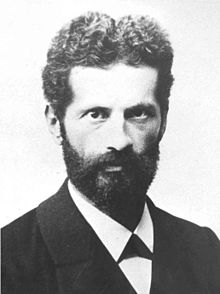Gottlieb Haberlandt
Gottlieb Haberlandt | |
|---|---|
 | |
| Born | 28 November 1854 Mosonmagyaróvár |
| Died | 30 January 1945 (aged 90) Berlin |
| Nationality | Austrian |
| Scientific career | |
| Fields | Botany |
Gottlieb Haberlandt (28 November 1854 – 30 January 1945) was an Austrian botanist. He was the son of European 'soybean' pioneer Professor Friedrich J. Haberlandt.[1] His son Ludwig Haberlandt was an early reproductive physiologist now given credit as the 'grandfather' of the birth control pill.
Haberlandt first pointed out the possibilities of the culture of isolated tissues, plant tissue culture.[2] He suggested that the potentialities of individual cells via tissue culture and also suggested that the reciprocal influences of tissues on one another could be determined by this method. Since Haberlandt's original assertions methods for tissue and cell culture have been realized, it has led to significant discoveries in Biology and Medicine. His original idea presented in 1902 was called totipotentiality (now termed as totipotency): “Theoretically all plant cells are able to give rise to a complete plant.”[3][4][5] In his 1905 work "Die lichtsinnesorgane der laubblätter" Haberlandt suggested that plants might be able to see using organs on the upper surface of the leaf.[6][7]
The more efficient C-4 photosynthesis in land plants depends on a specialized Kranz (German for wreath) leaf anatomy[clarification needed] first described by Gottlieb Haberlandt in 1904.[8]
References
[edit]- ^ Friedrich J. Haberlandt Part 1 – History of Soybeans and Soyfoods in the United States 1766–1900. Soyinfocenter.com. Retrieved on 2012-04-11.
- ^ Bonner, J. (1936). "Plant Tissue Cultures from a Hormone Point of View". Proc. Natl. Acad. Sci. 22 (6): 426–430. Bibcode:1936PNAS...22..426B. doi:10.1073/pnas.22.6.426. JSTOR 86579. PMC 1076796. PMID 16588100.
- ^ Haberlandt, G. (1902) Kulturversuche mit isolierten Pflanzenzellen. Sitzungsber. Akad. Wiss. Wien. Math.-Naturwiss. Kl., Abt. J. 111, 69–92.
- ^ Noé, A. C. (1934). "Gottlieb Haberlandt". Plant Physiol. 9 (4): 850–855. doi:10.1104/pp.9.4.850. PMC 439112. PMID 16652925.
- ^ Plant Tissue Culture. 100 years since Gottlieb Haberlandt. Laimer, Margit; Rücker, Waltraud (Eds.) 2003. Springer ISBN 978-3-211-83839-6
- ^ Clements, Frederic E. (1905). "Die Lichtsinnesorgane der Laubblätter . By G. Haberlandt. Leipzig, Wilhelm Engelmann. 1905. Pp. 142, pl. 4" (PDF). Science. 22 (559): 336–337. doi:10.1126/science.22.559.336. ISSN 0036-8075.
- ^ Yamashita, Felipe; Baluška, František (2022). "Algal Ocelloids and Plant Ocelli". Plants. 12 (1): 61. doi:10.3390/plants12010061. ISSN 2223-7747. PMC 9824129. PMID 36616190.
- ^ Haberlandt, G. 1904.Physiologische Pflanzanatomie. Engelmann, Leipzig.
Further reading
[edit]- Haberlandt, Gottlieb (1879). Die Entwicklungsgeschichte des mechanischen Gewebesystems der Pflanzen (in German). Leipzig: Verlag von Wilhelm Engelmann.
- Haberlandt, Gottlieb (1884). Physiologische Pflanzenanatomie (in German). Leipzig: Verlag von Wilhelm Engelmann.
- Haberlandt, Gottlieb (1890). Das reizleitende Gewebesystem der Sinnpflanze (in German). Leipzig: Verlag von Wilhelm Engelmann.
- Haberlandt, Gottlieb (1893). Eine botanische Tropenreise. Indo-malayische Vegetationsbilder und Reiseskizzen (in German). Leipzig: Verlag von Wilhelm Engelmann.
- Haberlandt, Gottlieb (1901). Sinnesorgane im Pflanzenreich zur Perzeption mechanischer Reize (in German). Leipzig: Verlag von Wilhelm Engelmann.
- Haberlandt, Gottlieb (1905). Die Lichtsinnesorgane der Laubblätter (in German). Leipzig: Verlag von Wilhelm Engelmann.


 French
French Deutsch
Deutsch